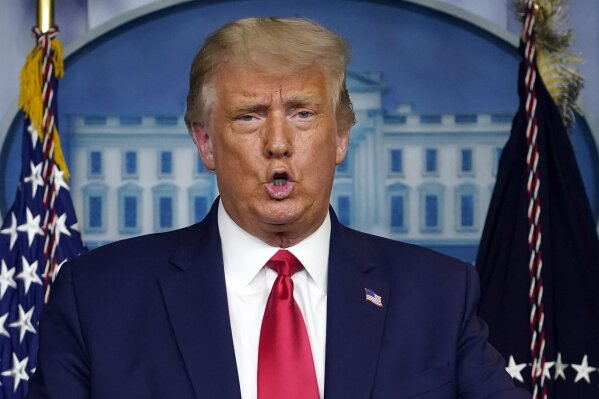AP FACT CHECK: Trump’s big distortions on mail-in voting
President Donald Trump on Thursday continued his monthslong campaign against mail-in voting this November by tweeting critically about the practice, building on complaints he has made all week. The president has recently been trying to distinguish between states that automatically send mail ballots to all registered voters and those that make voters request a mail ballot, but even there he’s badly distorted the practice.
A look at his statements and the facts:
TRUMP: “The big Unsolicited Ballot States should give it up NOW, before it is too late, and ask people to go to the Polling Booths and, like always before, VOTE. Otherwise, MAYHEM!!! Solicited Ballots (absentee) are OK.” — tweet Thursday.
THE FACTS: Trump is vastly overstating the potential for “mayhem” and fraud in “big unsolicited ballot states.”
There is no such thing as an “unsolicited” ballot. Five states routinely send ballots to all registered voters so they can choose to vote through the mail or in person. Four other states and the District of Columbia will be adopting that system in November, as will almost every county in Montana. Election officials note that, by registering to vote, people are effectively requesting a ballot, so it makes no sense to call the materials sent to them “unsolicited.”
More broadly speaking, voter fraud has proved exceedingly rare. The Brennan Center for Justice in 2017 ranked the risk of ballot fraud at 0.00004% to 0.0009%, based on studies of past elections.
In the five states that regularly send ballots to all voters, there have been no major cases of fraud or difficulty counting the votes.
___
TRUMP: “Because of the new and unprecedented massive amount of unsolicited ballots which will be sent to ‘voters’, or wherever, this year, the Nov 3rd Election result may NEVER BE ACCURATELY DETERMINED, which is what some want.” — tweet Thursday.
THE FACTS: It’s highly unlikely that any chaos in states with universal mail-in voting will cause the election result to “never be accurately determined.”
The five states that already have such balloting have had time to ramp up their systems, while four new states adopting it — California, New Jersey, Nevada and Vermont — have not. Of those nine states, only Nevada is a battleground, worth only six electoral votes and only likely to be pivotal in an absolute national presidential deadlock. The others, including the District of Columbia, are overwhelmingly Democratic and likely to be won by that party’s nominee, former Vice President Joe Biden.
The main states that are being contested — Arizona, Florida, Michigan, North Carolina, Pennsylvania and Wisconsin — only send mail ballots to voters who request them. Trump said Thursday that such “solicited” ballots are absolutely “OK.”
Trump frequently blasts mail-in voting as flawed and fraudulent while insisting that mail ballots in certain states such as Florida, a must-win state for him are fine and safe. But mail-in ballots are cast in the same way as what Trump refers to as “absentee” mail ballots, with the same level of scrutiny such as signature verification in many states. In court filings, the Trump campaign has acknowledged that mail-in and absentee ballots are legally interchangeable terms.
States nationwide expect a surge in mail-in voting due to the ongoing coronavirus threat.
___
TRUMP: “Unsolicited Ballots are uncontrollable, totally open to ELECTION INTERFERENCE by foreign countries, and will lead to massive chaos and confusion!” — tweet Thursday.
THE FACTS: Mail-in ballots aren’t the biggest risk for foreign interference.
Trying to influence a federal election through mail-in ballots would probably mean paying thousands of U.S. citizens, carefully selected in pivotal states, who are willing to conspire with a foreign government and risk detection and prosecution.
Far easier and cheaper would be a social media campaign seeking to discourage certain groups of people from voting, which is something the FBI has warned about. Or a cyberattack on voter registration data that would eliminate certain voters from the rolls. That could cause havoc at polling places or election offices as officials attempt to count ballots from people who are “missing” from their voter databases.
Attorney General Bill Barr has raised the possibility that a “foreign country could print up tens of thousands of counterfeit ballots.” He argued they would be hard to detect, but that’s been disputed by election experts.
Mail-in ballots are printed on special paper and must be formatted correctly in order to be processed and counted. Ballots are specific to each precinct, often with a long list of local races, and would be identified as fraudulent if everything didn’t match precisely.
___
TRUMP: “The Governor of Nevada worked very hard to cancel all of our venues. Despite the fact that he controls the state, he failed, but would have rather done rally outside. Can you imagine this man is in charge ... of the Ballots in Nevada!? Not fair, Rigged Election!” — tweets Monday.
THE FACTS: He’s making a baseless charge.
Trump singled out Nevada’s Democratic Gov. Steve Sisolak for his ire after Sisolak criticized Trump’s recent indoor rally in a Las Vegas suburb for violating the state’s large-scale ban on indoor gatherings. But there’s one problem — Sisolak is not in charge of the ballots in Nevada. The secretary of state runs that state’s new all-mail election. Her name is Barbara Cegavske, and she is a Republican.
Trump’s campaign is suing to overturn new all-mail-ballot rules in Nevada and Montana, where Democratic Gov. Steve Bullock said counties could send mail ballots to all voters and 46 of the state’s 56 have.
___
Associated Press writers Hope Yen and Eric Tucker contributed to this report.
___
EDITOR’S NOTE — A look at the veracity of claims by political figures.
___
Find AP Fact Checks at http://apnews.com/APFactCheck
Follow @APFactCheck on Twitter: https://twitter.com/APFactCheck



